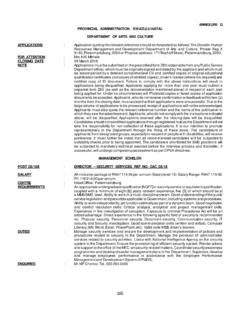Transcription of ISOCYANATES, MONOMERIC 5521
1 ISOCYANATES, MONOMERIC55212,4-TDI: CH3C6H3(NCO)2 :584-84-9 RTECS:CZ63000002,6-TDI: CH3C6H3(NCO) MDI: CH2(C6H4 NCO) HDI: OCN(CH2) NDI: C10H6(NCO) : 5521 , Issue 2 EVALUATION: UNRATEDI ssue 1: 15 May 1989 Issue 2: 15 August 1994 OSHA :Table 1 NIOSH:Table 1 ACGIH:Table 1 PROPERTIES: Table 1 SYNONYMS:Table 1 SAMPLINGSAMPLER:IMPINGER(solution of 1-(2-methoxyphenyl)-piperazine intoluene)FLOW RATE:1 L/minVOL-MIN:5 L @ 35 g TDI/m3 -MAX:500 LSHIPMENT:ship in screw-cap vialrefrigerated @ 4 C or lowerSAMPLE STABILITY:may be unstable; perform steps 7 & 8 as soonas possibleBLANKS:2 to 10 field blanks per setMEASUREMENTTECHNIQUE:HPLC, ELECTROCHEMICAL ANDUV DETECTIONANALYTE:urea derivatives of isocyanatesSAMPLE PREP:acetylate excess reagent, evaporate toluene, redissolve in 5 mL CH3 OHINJECTION VOLUME:10 LMOBILE PHASE:acetonitrile (20% to 40%)/pH buffer (80% to 60%)1 mL/min; ambient temperatureCOLUMN:Supelcosil, LC-8-DB, 3- m particle size, cm x ; 2-cm guard column,10- m particle sizeDETECTOR:242 nm; ECHD, + V vs.
2 Ag/AgClCALIBRATION:standard solutions of ureas in methanolRANGE:2,4-TDI: to 8 g per sample [1]2,6-TDI: to 10 g per sample [1]MDI: to 4 g per sample [1]HDI: 1 to 15 g per sample [1] NDI: to 13 g per sampleESTIMATED LOD:ca. g diisocyanate per sample [1]PRECISION (S r):not determinedACCURACYRANGE STUDIED:not studiedBIAS: not knownOVERALL PRECISION (S rT):not knownACCURACY:not determinedAPPLICABILITY: The working range is from 5 g/m3 2,4-TDI, 7 g/m3 2,6-TDI, 3 g/m3 MDI, 1 g/m3 HDI, and 2 g/m3 NDI tomore than 1 mg/m3 for 100-L air samples. This method determines the air concentration of specific diisocyanates. The methodhas been applied to samples from general foaming, spray- or dip-painting industries [1]. INTERFERENCES: Any substance which elutes with the ureas and is electroactive will interfere with the analysis. Mobile phaseconditions can be adjusted to separate most co-eluting peaks, however, ureas of HDI and TDI are difficult to separate.
3 OTHER METHODS: This method is a modification of Method MDHS 25 published by the Health and Safety Executive of GreatBritain [2,3]. Method 2535 is an alternate method for TDI vapor, employing collection on glass wool impregnated withN-(4-nitrophenylmethyl)propylamine. NIOSH Manual of Analytical Methods (NMAM), Fourth Edition, 8/15/94 ISOCYANATES: METHOD 5521 , Issue 2, dated 15 August 1994 - Page 2 of 6 REAGENTS: (2-Methoxyphenyl)piperazine*, 98%. anhydride, reagent grade. , HPLC grade. , HPLC grade. , deionized, distilled. acetate, anhydrous acid, glacial. , , HPLC medium, 1-(2-methoxyphenyl)-piperazine in toluene, 43 mg/L. (seeAPPENDIX A) derived from the isocyanate .(See APPENDIX B). sulfoxide, reagent phase, acetonitrile and buffer solutionto achieve appropriate mobile solution. Dissolve 15 g anhydroussodium acetate in 1 L distilled-deionized 1 L methanol.
4 Add glacial acetic acid tobring pH to calibration stock solution, g/ Lurea in calibration stock solution, g/ L1-(2-methoxyphenyl)-piperazine in , prepurified.*See SPECIAL PRECAUTIONSEQUIPMENT: : Midget impinger, 25-mL sampling pump, L/min, withflexible connecting tubing free of : Avoid collection of plasticizer in thetoluene during sampling. FluranTM tubing is anacceptable, PVC tubing is not. chromatograph (HPLC) withelectrochemical (ECHD) detector (+ V ), recorder, integrator and column(page 5521 -1) water bath. , 4-mL glass, with screw caps and 20-mLglass, screw caps with cone-shapedpolyethylene liner and shrinkable sealingbands. pipets, 7-cm glass, disposable. , volumetric, glass, 10-mL , sizes appropriate for preparingstandard solutions. , 5- and 15-mL glass, delivery, withpipet plate, spark free, 60 , Mini-Vap, 6-port or funnel, fritted glass, medium porosity, , filtration, PRECAUTIONS: Preparation of urea derivatives, samples, and standards should be donein a hood to avoid exposure to isocyanate and solvent vapors.
5 Isocyanates are known respiratoryirritants.[4] Toxicity of 1-(2-methoxyphenyl)piperazine is unknown. each personal sampling pump with a representative sampler in 15 mL sampling medium to an the assembled impinger to a sampling 5 to 500 L of air at 1:Toluene evaporates during sampling; when level of solution drops below 10 mL,restore volume to 15 mL with 2: The reagent in the sampling medium reacts with isocyanates to form ureas: CH3OC6H4NC4H8NH + R-N=C=O CH3OC6H4NC4H8NC(=O) blank samples by transferring 15 mL sampling medium to 20-mL the sample solution to a 20-mL vial for shipment. Rinse both impinger parts with 2 to 3mL toluene and add rinsings to the sample. Secure vial's screw cap with sealing band. Refrigerate samples as soon as possible. If samples are to be shipped, carefully pack the vialsto avoid breakage or spillage of Manual of Analytical Methods (NMAM), Fourth Edition, 8/15/94 ISOCYANATES: METHOD 5521 , Issue 2, dated 15 August 1994 - Page 3 of 6 SAMPLE 25 L acetic anhydride to acetylate the excess 1-(2-methoxyphenyl)piperazine remaining in the sample solution, to provide for efficient : The acetylation reaction is.
6 CH3OC6H4NC4H8NH + CH3C(=O)OC(=O)CH3 CH3OC6H4NC4H8NC(=O)CH3 + CH3C(=O) the acetylated sample to dryness under a gentle stream of nitrogen while warming to60 C on a the residue in mL methanol, while agitating the sample in an ultrasonic waterbath for 15 AND QUALITY at least six working standards containing to g/mL of the appropriate urea(s)(TDIU, HDIU, and/or MDIU) and 100 g/mL of 1-(2-methoxyphenyl)piperazine by adding aliquotsof calibration stock solutions to 2 mL methanol in a 10-mL volumetric flask. Add 10 L aceticanhydride to each standard. Mix and dilute to the mark with :The standard solutions need include only ureas derived from the diisocyanates expectedin the air working standards together with samples and blanks (steps 13 through 15). Preparea calibration graph for the urea in terms of quantity of isocyanate , M (ECHD area of isocyanate group per sample). Molecular weights of typical ureas are: TDIU = g/mol; MDIU = g/mol; HDIU = g/mol; NDIU = :M is the quantity of isocyanate per sample ( g)C is the concentration of urea in the standard solution ( g/mL)5 is the liquid volume of a sample (mL)MWu is the molecular weight of the ureaMWI is the molecular weight of the isocyanate12 Prepare control samples by adding , and g of urea to 15 mL sampling medium.
7 Prepare these samples for analysis (steps 7 through 9). the HPLC system according to manufacturer's recommendations and to the conditions givenon page a 10- L aliquot of the sample solution from step 10. Capacity factors for the ureaderivatives are:NIOSH Manual of Analytical Methods (NMAM), Fourth Edition, 8/15/94 ISOCYANATES: METHOD 5521 , Issue 2, dated 15 August 1994 - Page 4 of 6 Mobile Phase CapacityIsocyanateAcetonitrileBuffer SolutionFactor (k')a2,4-TDI30%70%2 MDI35%65%42,4-TDI40%60%3 HDI40%60%3 NDI60%40%3ak'= (tr - to) / to, where tr is the retention time of the urea and to is the retention time of an peak : from calibration graph the quantity, M ( g per sample), of isocyanate . the concentration of isocyanate , CM (mg/m3), in the air volumesampled, V (L):EVALUATION OF METHOD:The stability of 2,4-TDIU in toluene was investigated using groups of six samples stored at roomtemperature for up to two weeks or at 4 C for 1 week with the following results:StorageQuantityPeriodStoragePerc ent Recovery, ( g)(days)Temperature95% Confidence C88 11 The data demonstrate sample instability at room temperature (about 22 C) and suggest that thesamples are somewhat unstable even at 4 of the limits of quantitation (LOQs) (expressed in terms of the quantity of diisocyanate persample) were made from the electrochemical detector calibration curves used for the analysis of fieldsamples or control samples: 2,4-TDI, g [1, Sequence 6043]; 2,6-TDI, g [1, Sequence 6043];MDI, g [1, Sequence 6019]; HDI, 1 g [5]; NDI, g [1, Sequence 6878-C].
8 The correspondinglimits of detection (LODs) were: 2,4-TDI, g; 2,6-TDI, g; MDI, g; HDI, g; NDI, Manual of Analytical Methods (NMAM), Fourth Edition, 8/15/94 ISOCYANATES: METHOD 5521 , Issue 2, dated 15 August 1994 - Page 5 of 6 REFERENCES:[1]NIOSH - Measurement Research Support Branch Analytical Report, Sequences #6019, 6043,6100, 6354, and 6878-C (NIOSH, unpublished, 1988).[2]"MDHS 25: Methods for the Determination of Hazardous Substances, Organic Isocyanates in Air. Laboratory Method Using 1-(2-Methoxyphenyl)piperazine Solution and High Performance LiquidChromatography," Occupational Medicine and Hygiene Laboratory, Health and Safety Executive,London, (1987).[3]Bagon, D. A., C. J. Warwick, and R. H. Brown, Am. Ind. Hyg. Assoc. J., 45, 39-43(1984).[4]NIOSH/OSHA Occupational Health Guidelines for Chemical Hazards, Department of Healthand Human Services, Publ. (NIOSH) 81-123 (1981), available as GPO Stock #17-033-00337-8from Superintendent of Documents, Washington, 20402[5]User check, DataChem Inc.
9 , NIOSH analytical seq. #6543 (unpublished, Feb. 24, 1989).METHOD REVISED BY:M. J. Seymour and Rosa Key-Schwartz, , NIOSH/DPSETABLE 1: SYNONYMS, EXPOSURE LIMITS, AND PROPERTIESC ompounds (Synonyms)Exposure Limits, g/m3*Properties(OSHA)(NIOSH)(ACGIH)2,4-T DI(toluene-2,4-diisocyanate)140(ceiling) lowestfeasible(Ca) 36140 STEL(Ca)Liquid; d g/mL @ 20 C;BP 251 C; VP Pa ( mmHg) @ 20 C; MP C2,6-TDI(toluene-2,-6-diiocyanate)no PELlowestfeasible(Ca)no TLVliquid; d g/mL @ 20 C; Pa ( mm Hg) @ 20 CMDI(4,4'-methylenediphenylisocyanate; diphenylmethane-4,4'-diisocyanate; methylenebisphenyl isocyanate )200(ceiling)50;200/10 min(ceiling)51solid (fused); d g/mL @25 C; MP C; VP ( mm Hg) @ 20 CHDI (hexamethylenediisocyanate)no PEL35 140/10/min(ceiling)34liquid; d g/mL @ 20 C; BP255 C; kPa ( mm Hg)@ 25 CNDI (naphthylenediisocyanate)no PEL40;70/10 minno TLVsolid flakes; MP 127 C;VP < Pa @ 20 C* 1 ppm = 7100 g/m3 TDI; 10208 g/m3 MDI; 7350 g/m3 HDI.
10 Ca = CarcinogenAPPENDIX A: PURIFICATION OF 1-(2-METHOXYPHENYL)PIPERAZINE AND PREPARATION OFNIOSH Manual of Analytical Methods (NMAM), Fourth Edition, 8/15/94 ISOCYANATES: METHOD 5521 , Issue 2, dated 15 August 1994 - Page 6 of 6 SAMPLING MEDIUMP lace 25 g 1-(2-methoxyphenyl)piperazine (yellowish white solid) in a 250-mL beaker. Addapproximately 125 mL pentane. Bring to a boil (CAUTION: FLAMMABLE) on a hotplate and allow toboil until all but a small amount of yellow oil is in solution. The 1-(2-methoyphenyl)piperazine will meltas it is warmed in the pentane. Decant the solution into a clean beaker, cover with a watchglass andcool in the freezer for 2 to 3 h. White, fluffy crystals will form. Filter with a Buchner funnel. Transferthe crystals to a 50-mL round bottom flask and dry briefly under vacuum to remove final traces ofpentane. Store the hygroscopic crystals in an air-tight container in a refrigerator.
















